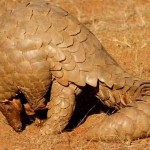Indian security forces arrest two men and seize fourteen kilograms of pangolin scales.
Last week, the Assam Rifles—an Indian paramilitary force—apprehended two young men and seized from them fourteen kilograms of pangolin scales, two mobile phones, and a bank card, according to online news source, E-Pao.
Pangolins’ scales make up about 20% of their body weight.
Asian species tend to weigh between five and seven kilograms, which means a single individual yields 1-1.4 kg of scales.
By these calculations, the fourteen kilos of scales seized by the Rifles could represent between ten and fourteen pangolins.
The Chinese and Indian pangolins are protected under Schedule I of India’s Wildlife Protection Act of 1972.
Violators of the Act face up to three years in prison, a fine of 25,000 rupees (just over US $500), or both.
Surging demand for pangolins
These animals are in high demand in East and Southeast Asia, with China and Vietnam identified as the largest consumer nations.
There, the flesh of adults and fetuses are consumed as delicacies and their scales are used to make traditional medicines.
According to wildlife trade monitoring network, TRAFFIC, pangolins are the most commonly encountered mammals in the illegal wildlife trade in Asia.
Read more about the illegal pangolin trade here.
Superstitious beliefs stimulate trade
Like other animal-based traditional Chinese medicines, pangolins’ body parts and scales are superstitiously used as somewhat of a “cure-all” remedy for things like reducing swelling, improving liver function, weight loss, stimulating blood circulation, and enhancing lactation in breast-feeding women.
There is no scientific evidence to support any of the medicinal claims made about pangolin body parts.
Rhino horn and pangolin scales, much like our own hair and nails, are chiefly composed of keratin.
Studies have repeatedly shown rhino horn to be void of any curative properties.
Pangolin decline overshadowed by more charismatic species
Being less charismatic than animals like tigers, elephants, and rhinos, the extremely rapid loss of the scaly anteaters is largely overlooked, which may be one of the most concerning issues surrounding their plight.
Bringing awareness to the direct destruction of these animals and their habitat is one of the most important assets in securing the future of the world’s pangolins.
Author: Sarah Pappin. Read more about Sarah here.
Image: Joxerra Aihartza (Nire argazki-bilduma / own picture) via Wikimedia Commons







Comments are closed.